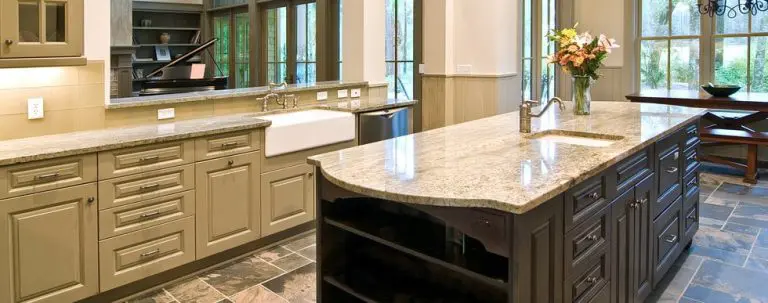
Are you choosing floor tiles and like the idea of a natural stone? Stone floor tiles will work in most rooms of the house, but are especially popular in the hallway, kitchen and bathroom. From the palest marble and limestone to the darkest slate and granite, the design possibilities of stone flooring are vast. Our guide real stone flooring is here to help you find the best option for your home.
Prices vary enormously and will depend on the grade and quality of the stone. Most stone is newly quarried but reclaimed slabs are available, which, although considered more environmentally friendly, are usually more expensive.
Stone floors are widely considered to add value to a property, but choose wisely as once laid you won’t want to change them for years. They can also be very difficult and expensive to remove. Here are the natural stones you can choose from:
Easily split into various thicknesses and available with a textured finish, slate works well in wet areas.
Slate sits at the cheaper end of the spectrum, costing as little as $10 per m² from a high street or online supplier, up to £50 per m² for interesting colours and textures from specialist suppliers.
Available in a wide spectrum of colours, often with mineral specks or subtle veining granite is a flexible choice that can be adapted to most house styles. It comes in different finishes, but it is the polished form that fully reveals the colours and patterns. Colours range from blue and purple shades through to grey and olive green, and they often include rusty red markings.
Granite floor tiles typically cost from $30 per m² for basic and uniform, black small format tiles. Expect to pay, on average, between $50-£70 per m² for larger format tiles, that have a more interesting and colourful finish. The limitless variations of granite flooring colours and textures means that it is hard to put a price on some of the rare examples available. It is very possible to spend in excess of $150 per m² to find the perfect patterning for your floor.
Starting its life as limestone, under certain conditions its components crystallize to form the veins typical of marble. In its purest form, it can be found in a wide range of other shades, from various greys through to green and black.
Marble floors come in at a similar price to granite, with an equal number of variations in colour and texture on the market. Expect to pay from $50 per m² for the most basic tile, to as much as $150 or $200 per m² for decorative tiles or tiles with specialist colour-ways and finishes.
The finish you choose will affect the overall look of your tiles and, as a result, your room. This glossary tells you what’s what in floor tile finishes.
Stone tiles can be cold and hard underfoot, and this needs to be considered when deciding where to lay it. In a south-facing room, stone will adopt the ambient temperature and warm with the sun, but if you have a north-facing room that has the potential to become cold, a stone floor may not be the ideal choice. This said, you can soften a stone floor with a rug.
China and glass will almost certainly break if dropped on a solid stone floor. Some polished surfaces can be slippery in bathrooms, but there are textured tiles with non-slip finishes. The best way to find out if a floor covering is suitable for your space is to ask your supplier; if your selected tile isn’t appropriate, they will be able to suggest a similar option that is.
Solid stone floor tiles are the perfect partner for underfloor heating because of the ease at which it absorbs and emits heat. This can be especially useful in a bathroom or kitchen. Not only will it feel pleasant under bare feet, but it is also an effective way of reducing the risk of damp because of the constant ambient temperature in the room.
It is possible to lay stone floor tiles yourself if you’re a keen DIYer with the correct tools, time, patience and you don’t mind making one or two mistakes. For the sake of a weekend’s work, you could use the +$1,000 of installation costs elsewhere. If you do decide to lay it yourself, do your homework first or at least have a professional assess the job for you.
Other considerations include whether your joists will take the weight of large tiles or thick flagstones – timber floors may need strengthening.
Source: Real Homes
Reference: https://www.realhomes.com/buyers-guide/how-to-choose-real-stone-flooring
EuroGranite Inc. has been in business since 1999. We create incredible works of art using luxurious granite, quartz, and marble products.